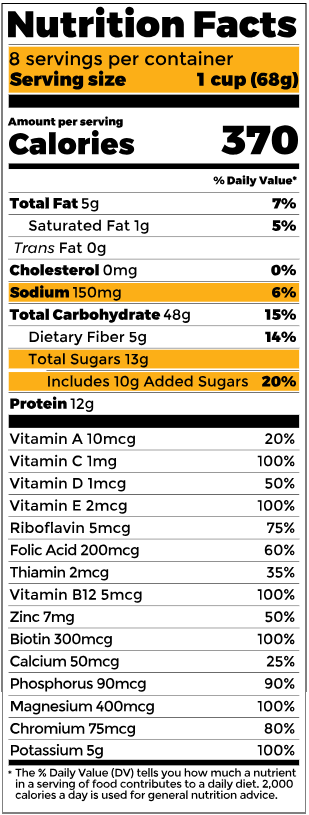When you first look at a nutrition facts label, it’s easy to want to zero in on the calorie count alone. But remember, eating healthy is about eating the right food, not less food! There are many healthy foods that have a higher calorie count, just like there are many unhealthy foods that are marketed as “low calorie,” “low fat,” and “low sugar.”
On every packaged food item, you will find a nutrition facts label [pictured]. Here are six helpful tips to help you make healthy choices for your family.*

1. Sodium: Look for packaged products that have 140mg or less of sodium per serving. This will help to ensure that you stay within the recommended dietary guidelines of 2300 mg per day, which is equal to about one teaspoon of salt. Yes, you read that right! Enjoy up to 1 teaspoon of salt per serving. Sodium is an important and essential nutrient for the body, but is not needed in large amounts. Sodium helps the body to balance fluids and supports healthy nervous system functions.
2. Sugar: Look for packaged products with 4g or less of sugar per serving. Four grams is equal to about 1 teaspoon. To calculate how much sugar is in a packaged product, simply divide the number of grams by 4 to get the number of teaspoons per serving. Example: If your nutrition label lists 24g of sugar, then in one serving, you will be consuming 6 teaspoons of sugar. Would you put that much sugar in your body at on one time? Probably not! Limiting sugars in your diet can help prevent cavities and lower your risk of heart disease, diabetes, and other chronic illnesses.
3. Ingredients list: Read the ingredients list. Ideally, the list will be short, with maybe 5-10 ingredients. Look for words like “whole” (e.g. “whole grain), and ingredients you recognize and can pronounce.
4. Servings: Look at both the serving size and servings per container. Here’s the tricky part: A nutrition label typically lists the information for a single serving (which may or may not be the whole container!). So, if a can of soup lists two servings per container and you plan to eat all of the contents of the can, you will double all the numbers on the nutrition facts label to account for both servings.
5. Other nutrients: Aim for more nutrients like fiber, vitamins A and C, iron, and calcium. Look for foods low in saturated fat, trans fat, sodium, sugar, and cholesterol.
6. Compare: We all have certain products that we love and are loyal to, but next time you’re at the grocery store, try a side-by-side comparison using the tips above. You might find something that’s a little bit healthier for you – and it might even taste better!
*Note: If you have high blood pressure or other medical issues, please consult your physician for your particular dietary needs.
By: Gary Appelsies MS, CHHC, AADP
Director of Healthy Eating
